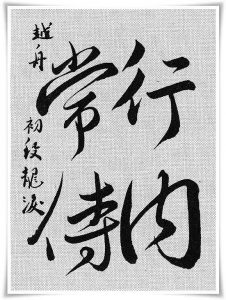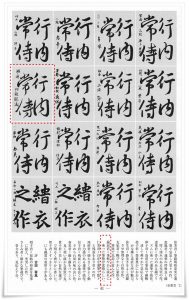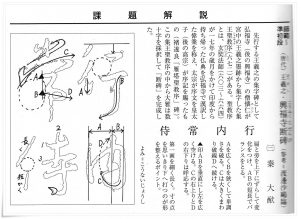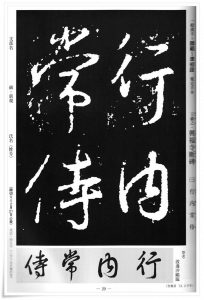Text: Ponte Ryūrui (品天龍涙)
English editing: Rona Conti

Yesterday, I found out that one of my rinsho (臨書, りんしょ, lit. “copying masterpieces) works submitted every month for examination purposes was printed in the monthly magazine of the All Japan Calligraphy Art and Literature Association (全日本書芸文化院, ぜんにほんしょげいぶんかいん, Zen Nihon Shogei Bunkain). You will surely understand how pleasantly surprised I was when I tell you that the association has easily over 20,000 members, and only 32 works were chosen to be reproduced. Thus, I feel that this is an excellent opportunity to say a few words about the process for studying calligraphy. My previous article on the subject of rinsho meshes with this one, but additionally, I shall explain details about the process of calligraphy exams in Japan.
There are two major study categories: kanji (漢字, かんじ, kanji) and kana (かな). Each of those is further divided into three levels. The levels or rankings are similar to those in the martial arts. One starts at the entry level of 10th kyū (級, きゅう, lit. “rank”). There are ten kyū’s in total. And there are assignments for rankings based upon the varying levels. One works from 10th kyu down to 1st kyu. The next level from the kyu category is dan (段, だん, lit. “grade”, “rank”).

The number of dan rankings depends upon the association. All Japan Calligraphy and Literature Association has only 3 dan’s (whereas some other organisations have as many as 9). The fewer dans, the more work and skill it takes to reach a higher rank, and, in my opinion, the more serious is the association. The rank after the 3rd dan is jun shihan (準師範, じゅんしはん, pre-master level) and finally, shihan (師範,しはん, master level). Shihan is the highest rank one can obtain. Naturally the skill of an 80 year old Master will be completely different from that of a 24 year old Master (by saying Master I mean a person who holds a Master Calligrapher certificate). While of course it is very gratifying to have been chosen to have one’s work reproduced and held up as an example of superior study, as with all things in life, what really counts is your continuous efforts and passion for studying. The greater the effort, the more the likelihood of improving and reaching your highest ability. The rest is irrelevant.

Exam requirements, that is, the pieces you are assigned to work on, differ from level to level. Obviously, the more advanced the level, the more difficult or complex the assignment. Consequently, the study materials are divided into three groups: 10th to 5th kyū , 5th to 1st kyū, and then 1st dan (初段, しょだん, shodan) to master level. Up to the 2nd dan one is expected to submit two types of rinsho. One of them is 2 characters of an ancient masterpiece each month until the text fragment that is reprinted in the magazine is complete, and 2 – 4 characters from a randomly chosen ancient masterpiece. The second rinsho is explained in detail by one of the top masters in the organisation (Figure 3). There are a few words about the masterpiece and the author (in this case it is Wang Xizhi {王羲之, pinyin: Wáng Xīzhī, 303–361 C.E.}), and then each of the characters has a dedicated analysis. Additionally, as you can see, there are hand-drawn instructions emphasising key features of a given hand writing. This is incredibly important, and understanding those is absolutely vital to comprehending the given style. If you look closely at Figure 3, you will notice that the instructions are very detailed.

Nevertheless, the approach to rinsho differs (or should differ) from person to person. I purposely reproduced the entire page (Figure 2) that includes my work (marked by a red dotted line) and works of other students to show you that rinsho is not about creating a perfect copy, but about understanding the feelings and mood of the calligrapher who wrote the given masterpiece. One should study the rhythm, the energy, and the key features of the text, while, at the same time, imbuing it with your own personality. This is the way to true mastery of calligraphy, to finding your own personal style which is in synchronicity with the ancient tradition, yet is creative and original.
The comment on my work (magnified in Figure 3) reads: “The lightness and the smoothness of the flow of brush strokes in Ryūrui’s work is outstanding”. It is a most flattering comment, particularly since I wrote this calligraphy when I was dead tired after a night of work, having been awake for nearly 24 hours. So, theoretically (see here my article that says a few words about the five harmonies and disharmonies), I was not supposed to be able to write well. The semi-cursive script (行書, ぎょうしょ, gyōsho) of Wang Xizhi is so powerful that its magic must have kept me awake.
